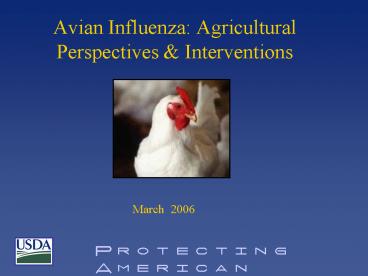Avian Influenza: Agricultural Perspectives - PowerPoint PPT Presentation
1 / 13
Title:
Avian Influenza: Agricultural Perspectives
Description:
AI viruses vary widely in pathogenicity from strain to strain. ... 1924 'Fowl Plague' affected live bird markets in the Northeastern U.S. ... – PowerPoint PPT presentation
Number of Views:31
Avg rating:3.0/5.0
Title: Avian Influenza: Agricultural Perspectives
1
Avian Influenza Agricultural Perspectives
Interventions
March 2006
2
Topics Covered
- Avian Influenza Overview
- USDAs AI Interventions
- Targeted surveillance
- Trade restrictions
- Border protection
- Outreach education
- Preparedness response
3
Avian Influenza Overview
- AI viruses mutate easily only H5 and H7 viruses
have the potential to mutate from an LPAI to an
HPAI form. - AI viruses vary widely in pathogenicity from
strain to strain. Therefore not all H5N1 viruses
are infectious for people or pathogenic to
poultry. - Vast majority of AI viruses found in birds do not
represent a public health concern
4
Three HPAI Findings in U.S.
- 1924 Fowl Plague affected live bird markets
in the Northeastern U.S. - 1983 destruction of 17 million birds in PA
- 2004 quickly contained and eradicated in TX
5
USDAs AI Interventions
- USDAs safeguarding system encompasses
- Targeted surveillance/Cooperative efforts with
States and Industry - Trade restrictions
- International assistance to prevent introduction
in the U.S. - Border protection
- Outreach and education
6
Targeted Surveillance/Cooperative Efforts
- USDA and States conduct surveillance through
- National Poultry Improvement Plan (NPIP)
- State and University laboratories Evaluation of
birds with clinical signs of disease - Testing at slaughter to meet export requirements
- State programs and movement requirements
- AI testing, surveillance and sanitation standards
for live bird markets
7
Targeted Surveillance/Cooperative Efforts (cont.)
- Migratory bird surveillance and testing in Alaska
and Atlantic flyways (expansion underway) - USDA scientists have improved AI tests, developed
bird vaccines, and provided insight into
transmissibility through genetic research - International assistance to HPAI-affected
countries to educate, prevent, and eradicate the
virus
8
Trade Restrictions
- USDA maintains trade restrictions on countries
affected by H5N1 - Cambodia, China, Croatia, Indonesia, Japan,
Kazakhstan, Laos, Malaysia, Romania, Russia,
South Korea, Thailand, Turkey, and Vietnam - Poultry and poultry products from those countries
are strictly prohibited. - USDA works with trading partners and the World
Organization for Animal Health (OIE) to maintain
safe trade.
9
Border Protection Risk of Introduction of Asian
Strain of H5N1
- USDA works closely with DHS to prevent smuggling
of illegal poultry and poultry products. - USDAs Smuggling Interdiction and Trade
Compliance unit and DHS Customs and Border
Patrol actively monitor U.S. ports. - Legally imported birds from other countries are
tested for AI.
10
Outreach Education
- USDAs Biosecurity for the Birds Campaign is an
extensive and far-reaching outreach initiative
designed to - Educate non-commercial poultry owners about the
signs of AI other poultry diseases - Promote the importance of practicing biosecurity
- Encourage rapid reporting of clinical signs of
disease and/or unexpected deaths
11
USDA AI Web Sitewww.usda.gov/birdflu
- Information about Biosecurity for the Birds
program - Links to other Federal entities working on AI
- Fact Sheets and other information resources
- QA on AI
- News Releases
- Technical Briefings
12
Preparedness in the Event of an Outbreak
- Key is early detection and rapid response
- USDA maintains a comprehensive emergency response
structure - Partnerships with local, State, and Federal
organizations - Integration with the National Response Plan
- Continual collaboration with HHS, DHS and other
Federal entities - Diagnostic capabilities
13
Response in the Event of an HPAI Outbreak
- USDA is prepared to respond to any potential
outbreak of HPAI in poultry. - In partnership with local, State, and Federal
entities, USDA maintains comprehensive plans to
respond to AI and other animal diseases. - Response actions include
- Quarantine and humane euthanasia of affected
flocks - Cleaning and disinfection of affected premises
- Possible use of vaccine in poultry, if
appropriate - Indemnity payments for lost birds and property.































